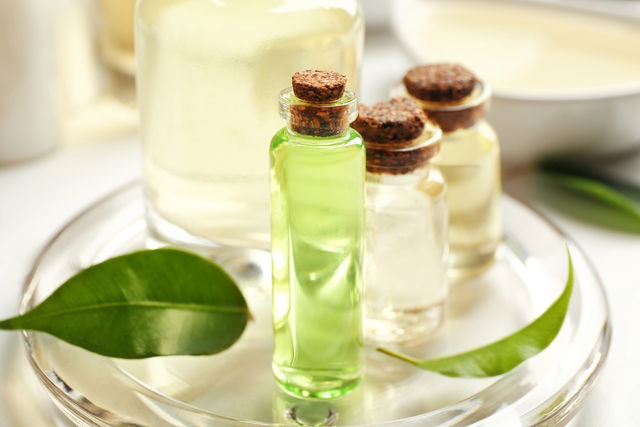Tea tree oil is extracted from the Melaleuca alternifolia plant and has been used in traditional medicine since early civilization to treat various health problems. It contains various medicinal properties which have been proven in many scientific studies.
Tea tree oil contains antiseptic, antifungal, parasitic, germicide, antibacterial and anti-inflammatory properties. This makes the extract a great way to naturally disinfect wounds, improve the appearance of acne and treat fungal nail infections.
The benefits of tea tree oil can be reaped when applied topically to the skin. It should not be consumed orally, as it can cause poisoning.

Health benefits
The main benefits of using tea tree oil include:
1. Treating nail fungus
Due to its antifungal properties, tea tree oil can treat mycosis in the nails. It can be used on its own or in combination with other medications.
How to use: Mix 2 or 3 drops of tea tree oil with a plant-based oil (like almond or coconut oil) and apply to the affected nails.
2. Treating yeast infections
Tea tree oil can be used to treat many genital infections, like yeast infections, bacterial vaginosis or trichomoniasis. It is powerful against infections due to its antimicrobial properties. Tea tree oil can also help relieve associated symptoms and speed up recovery. Please note that tea tree oil should not be used to substitute your medically prescribed treatment.
How to use: Dilute the tea tree oil in another plant-based oil, like almond oil, and apply to the genital region. If you’re looking to treat a vaginal yeast infection naturally, check out sitz bath preparations you can try to complement your medical treatment.
3. Disinfecting wounds
Due to its bactericide properties, tea tree oil is very effective in eliminating bacteria like E. coli, S. pneumoniae, H. influenzae, S. aureus or other bacteria that can cause infections in open wounds. In can also speed healing and reduce local inflammation.
How to use: Mix one drop of tea tree oil with a teaspoon of almond oil and apply a small amount of this mixture to the wound. Then cover with a dressing. You can repeat this twice per day until the wound has healed completely.
4. Improving acne
Tea tree oil works to reduce acne because of its anti-inflammatory properties and ability to prevent the growth of bacteria. This is seen with the treatment of Propionibacterium acnes, a bacteria that causes acne.
How to use: Look for skin gels or serums made with tea tree oil and use as instructed. You can also mix 1 mL of tea tree oil in 9 mL of water and apply the solution to affected region once or twice per day.
5. Eliminating dandruff
Tea tree oil is very effective for the treatment of dandruff. It improves the overall appearance of the scalp and helps to soothe itching.
How to use: You can purchase a shampoo that contains tea tree oil and use it on a daily basis. Otherwise, you can add some drops of tea tree oil to your shampoo and use it whenever you wash your hair.
6. Repelling insects
This oil can also be used as an insect repellant. It is even more effective when used in products that additionally contain DEET. Tea tree oil can also be used to prevent a lice infection or to help get rid of them while also helping to soothe itching.
How to use: To repel insects, you can make dilute tea tree oil in a spray bottle with almond oil and mix in other essential oils, like lavender or citronella. To treat lice, add 15 to 20 drops of tea tree oil to your regular shampoo and massage it gently into the scalp with the tips of your fingers.
7. Treating athlete’s foot
Athlete’s foot is a type of fungal infection that is difficult to treat, even with antifungal medications. Using tea tree oil as a complement to your medical treatment can help improve treatment outcomes and even shorten treatment duration. The oil can also help to address related symptoms, like itching and inflammation.
How to use: Mix half a cup of arrowroot flour and half a cup of sodium bicarbonate. Then add 50 drops of tea tree oil. This mixture can be applied to the feet and toes twice per day. Check out other treatments for fungal infections that may be recommended to you by your doctor.
8. Preventing bad breath
Tea tree oil can help to combat microorganisms that cause cavities and bad breath due to its antiseptic and antibacterial properties.
How to use: Add one drop of tea tree oil to a cup of warm water, and gargle the solution for about 30 seconds.
Contraindications to consider
Tea tree oil should only be used externally, as it can be toxic if swallowed. When used on the skin, you should dilute it first to avoid irritation, especially in those who have skin sensitivity.
Side effects
Tea tree oil is generally well-tolerated, however it can cause rare side effects like skin irritation, allergic reactions, itching,burning, redness and skin dryness.
This oil is toxic if swallowed, and can cause confusion, difficulty controlling muscle movements and decreased level of consciousness.
